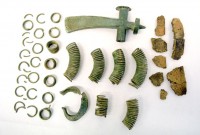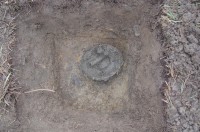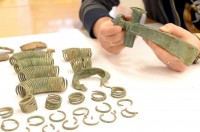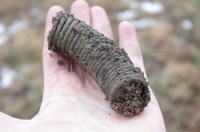 A 3,500-year-old Bronze Age hoard containing the head of an ice axe, fragments of a spiral necklace and a bracelet with tapered ends, all made of bronze, was found last month in the village of Rzepedź in Bieszczady Mountains of southeastern Poland. The hoard was discovered by Łukasz Solon from the nearby town of Sanok who was visiting the old wooden church of St. Nicholas with his girlfriend. They were walking towards the north side of the village when Łukasz noticed a metal object sticking out of the ground. Its green patina contrasted against the brown grass reminded him of artifacts he had seen in the Historical Museum of Sanok, so instead of indulging a perfectly natural curiosity and digging it up, Łukasz left the object alone and alerted the museum experts when he got home.
A 3,500-year-old Bronze Age hoard containing the head of an ice axe, fragments of a spiral necklace and a bracelet with tapered ends, all made of bronze, was found last month in the village of Rzepedź in Bieszczady Mountains of southeastern Poland. The hoard was discovered by Łukasz Solon from the nearby town of Sanok who was visiting the old wooden church of St. Nicholas with his girlfriend. They were walking towards the north side of the village when Łukasz noticed a metal object sticking out of the ground. Its green patina contrasted against the brown grass reminded him of artifacts he had seen in the Historical Museum of Sanok, so instead of indulging a perfectly natural curiosity and digging it up, Łukasz left the object alone and alerted the museum experts when he got home.
Archaeologist Peter Kotowicz from the Historical Museum of Sanok and Marcin Glinianowicz from the Carpathian Archaeology department of Sanok’s Folk Architecture Museum went to the site the next day and recovered the exposed object. They recognized it as an ancient bronze ice axe and immediately applied for an emergency permit to conduct an archaeological survey of the spot. The day after that, permit in hand, they excavated the find site.
 First they explored the area with a metal detector and found fragments of bronze spirals and a strong signal indicating that there was more to found deeper underground. They dug a small trench about two feet square and carefully raked into the soil, recovering multiple pieces of bronze spirals until, about a foot under the surface, they encountered potsherds that were the edges of a clay vessel about 10 inches in diameter. Much larger sections of bronze spirals lay within the vessel’s perimeter. Underneath those archaeologists found another 15 bronze spiral fragments and a bracelet with tapered end broken in two pieces. When they got to the bottom they discovered the earthenware vessel had been deliberately placed upside-down on a circular sandstone plate.
First they explored the area with a metal detector and found fragments of bronze spirals and a strong signal indicating that there was more to found deeper underground. They dug a small trench about two feet square and carefully raked into the soil, recovering multiple pieces of bronze spirals until, about a foot under the surface, they encountered potsherds that were the edges of a clay vessel about 10 inches in diameter. Much larger sections of bronze spirals lay within the vessel’s perimeter. Underneath those archaeologists found another 15 bronze spiral fragments and a bracelet with tapered end broken in two pieces. When they got to the bottom they discovered the earthenware vessel had been deliberately placed upside-down on a circular sandstone plate.
According to Kotowicz, the discovered objects were probably made south of the Carpathians. “The treasure is probably related to the communication route, which ran from the nearby Łupków Pass through the Osława and San valleys” – noted the archaeologist.
Bronze monuments from Rzepedź have been preliminarily dated to approx. 1500 years before Christ. “We do not yet know who and why had hidden the treasure so carefully. Axe and jewellery are most likely related to the Piliny culture, then existing south of the Carpathians” – noted Kotowicz.
 The Piliny culture is one of the Urnfield cultures, named after their practice of cremating their dead, placing the remains in urns that would then be buried in cemeteries that in some cases have been found to contain thousands of urn burials. Archaeologists have found pottery vessels of different shapes and sizes, bronze pins, bracelets, rings, weapons and more in those Piliny cemeteries and in settlements and hoards. The bronze work is particularly exceptional, the product of a well-developed metallurgic trade courtesy of the Carpathian mountains’ plentiful supply of ore. The area was an important center of metallurgy from the Early Bronze Age on, introducing innovations in the making of alloys and other metallurgic techniques.
The Piliny culture is one of the Urnfield cultures, named after their practice of cremating their dead, placing the remains in urns that would then be buried in cemeteries that in some cases have been found to contain thousands of urn burials. Archaeologists have found pottery vessels of different shapes and sizes, bronze pins, bracelets, rings, weapons and more in those Piliny cemeteries and in settlements and hoards. The bronze work is particularly exceptional, the product of a well-developed metallurgic trade courtesy of the Carpathian mountains’ plentiful supply of ore. The area was an important center of metallurgy from the Early Bronze Age on, introducing innovations in the making of alloys and other metallurgic techniques.
 The bronze spiral fragments in the Rzepedź hoard are typical of jewelry that has been found at Piliny sites. They used that spiral configuration in all kinds of designs: arm rings, leg rings, wrist guards, finger rings, pendants.
The bronze spiral fragments in the Rzepedź hoard are typical of jewelry that has been found at Piliny sites. They used that spiral configuration in all kinds of designs: arm rings, leg rings, wrist guards, finger rings, pendants.
In order to ascertain whether the hoard was a one-off buried in a remote location far from the madding crowd or part of a larger settlement, the find site will have to be more extensively explored. A survey or the wider area has already begun, a first step to a broader program of research under the aegis of the regional conservation office.
What would a complete piece of ‘spiral’ jewellery actually have looked like ? What hints are there to assume an ‘ice axe’ ? Taking a metallurgic context into consideration, what kinds of ‘bronze’ alloys have been found ?
Could, for instance, spiral money or -ingots, ingots/weights that can be worn around wrists and what I would call a ‘testing-/ portioning hammer’ play a certain role here ?
Depending on the alloy (Cu, Zn, Sn and others), the resulting bronze could have indeed different qualities. So if an alloy needs to have a certain percentage of Sn, you need to have a way to ensure that.
Whenever I see these spiral “jewelry” things, I can’t help noticing that they are not decorated, and seem to come apart in pieces really easily. Which puts me in mind of “proto money” like ring coins. These things look less like jewelry to me, and more like things to carry around strung on thongs and clipped off to purchase goods. “I’ll give you nine windings of a 2 cm roundrel for that sickly-looking chicken you’re trying to tout as a fine egg-layer, there.”
ESPECIALLY given that roundrel-wound wire is not a very stable shape for a mobile person. If it was used as jewelry, we should be seeing more of it stretched out in odd fashion where habitual wear distorted it out of sheer weight.
…of course, being a modern maille weaver, I tend to look at spirals and think they should be clipped, so this is a biased view.